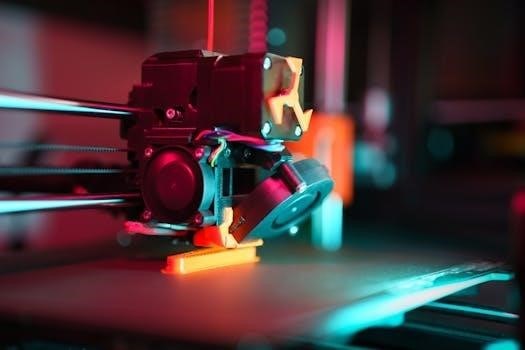Making Connections Lab⁚ Answer Key Overview
The “Making Connections” lab explores patterns and relationships, emphasizing critical thinking. Answer keys offer solutions and explanations for the lab’s questions and exercises. These keys aid comprehension, ensuring students understand the concepts and skills practiced in the lab activity, like analyzing data.
Understanding the “Making Connections” Lab Concept
The “Making Connections” lab concept centers around developing critical thinking and analytical skills. It encourages students to identify relationships, patterns, and links within various datasets and scenarios. The lab emphasizes the importance of observation, data interpretation, and logical reasoning. Students explore connections in diverse contexts, enhancing their understanding of cause-and-effect relationships and the interconnectedness of phenomena.
The lab activities often involve analyzing experimental data, interpreting graphs, and drawing conclusions based on evidence. Students learn to formulate hypotheses, test them through experimentation, and evaluate the results. Safety protocols are emphasized, ensuring responsible behavior during laboratory activities. The lab aims to promote scientific inquiry and develop students’ ability to make informed decisions based on evidence.
By engaging in these activities, students develop essential skills for scientific investigation and problem-solving. The “Making Connections” lab fosters a deeper understanding of how different elements interact and influence each other, contributing to a more holistic and interconnected view of the world. The activities in the lab are designed to mirror real-world scientific investigations, allowing students to experience the process of discovery firsthand. The lab also focuses on improving skills in areas such as skills practice and reading comprehension exercises.

Key Components of the Lab Packet
The “Making Connections” lab packet typically includes several key components designed to guide students through the experimental process. These components work together to facilitate understanding and critical thinking. The packet generally starts with an introduction outlining the lab’s purpose and learning objectives; This section provides context for the activities and sets expectations for student outcomes.
A detailed procedure section follows, providing step-by-step instructions for conducting the experiment or investigation. Safety guidelines are prominently featured to ensure responsible and safe practices. Data collection tables or worksheets are included to help students organize their observations and measurements. These tables often have a list of multiple choice questions, diagram questions, and constructive response questions.
Analysis questions prompt students to interpret their data, identify patterns, and draw conclusions. These questions encourage critical thinking and the application of scientific principles. Finally, a conclusion section allows students to summarize their findings and reflect on what they have learned. The lab packet may also include pre-lab reading materials or background information to provide context for the experiment. These materials help to build the student’s understanding and vocabulary around the topic. Skills practice exercises are also an important component of the lab packet.
NYS Regents Questions and the “Making Connections” Lab
The “Making Connections” lab is a cornerstone of the New York State (NYS) Regents Living Environment curriculum. It emphasizes scientific inquiry and data analysis. Therefore, questions related to this lab frequently appear on the NYS Regents exam. These questions assess students’ understanding of the lab’s objectives, procedures, and the underlying scientific principles.
Regents questions often require students to analyze data collected during the lab, such as pulse rates and activity levels. Students may need to identify patterns, draw conclusions, and explain the relationships between variables; Questions may also focus on experimental design. Students could be asked to evaluate the validity of a hypothesis or suggest improvements to the experimental procedure.
Furthermore, the Regents exam may include questions about safety precautions and the responsible conduct of scientific investigations. To prepare for these questions, students should thoroughly understand the “Making Connections” lab. They should carefully review their data, analysis, and conclusions. Furthermore, students should practice answering sample Regents questions related to the lab. This will familiarize them with the question format and the level of detail required for a complete answer. There are past Regents exams that can be used to prepare for the exam.
Analyzing Patterns and Connections in Lab Data
Analyzing data for patterns and connections is at the core of the “Making Connections” lab. This lab encourages students to move beyond simple observation. It challenges them to identify meaningful relationships within the collected data. This process involves a careful examination of the data to uncover trends, correlations, and anomalies.
Students begin by organizing their lab data into tables and graphs. This allows for a clear visual representation of the findings; They then look for patterns, such as a consistent increase in pulse rate with increased activity. Or, they might observe variations in pulse rate among individuals with different physical characteristics.
Identifying connections requires critical thinking. Students must ask themselves why these patterns exist. What underlying mechanisms might explain the observed relationships? Is there a cause-and-effect relationship between variables? Or are there other factors influencing the results?
The lab also emphasizes the importance of evaluating the strength of the connections. Are the observed patterns consistent and statistically significant? Or could they be due to chance or experimental error? By carefully analyzing the data and considering these questions, students develop their scientific reasoning skills. They learn to draw evidence-based conclusions.

The Relationship Between Exercise and Heart Rate (Pulse Rate)
The “Making Connections” lab often explores the direct correlation between exercise and heart rate. Exercise demands more energy, increasing the body’s need for oxygen. This demand triggers a physiological response, causing the heart to pump blood more rapidly. The result is an elevated pulse rate.
During physical activity, muscles require more oxygen to function efficiently. The circulatory system responds by delivering oxygen-rich blood at a faster rate. This increased blood flow ensures that muscles receive the necessary nutrients and oxygen to sustain activity.
The heart rate, measured as pulse rate, is a direct indicator of the cardiovascular system’s response to exercise. A higher pulse rate indicates a greater effort by the heart to meet the body’s oxygen demands. The intensity of exercise directly influences the degree of heart rate elevation.
The lab aims to demonstrate this relationship through practical experimentation. By measuring pulse rates before, during, and after exercise, students observe the changes in heart rate. They can then analyze the data to confirm the positive correlation between exercise and pulse rate. This provides firsthand experience of the body’s response to physical activity. It helps solidify their understanding of cardiovascular physiology.
Hypothesis Formation and Testing in the Lab
In the “Making Connections” lab, forming a hypothesis is a crucial step in the scientific process. A hypothesis is a testable prediction or explanation based on prior knowledge and observations. It guides the design of the experiment and the interpretation of results.
Students begin by identifying a relationship they want to investigate, such as the effect of exercise on heart rate. Based on this, they formulate a specific, testable statement. For instance, “Increased exercise will result in an increased heart rate.” This statement becomes the working hypothesis for the lab.
Testing the hypothesis involves collecting data through experimentation. Students perform the activity, carefully measuring and recording relevant variables. In the exercise example, they measure heart rate at rest and after different levels of exercise. This data provides the evidence needed to evaluate the hypothesis.
After collecting data, students analyze the results to determine if they support or refute the initial hypothesis. If the data consistently shows that heart rate increases with exercise, the hypothesis is supported. If the data is inconsistent or contradictory, the hypothesis may need to be revised or rejected. This process reinforces the scientific method and fosters critical thinking skills.

Skills Practice and Reading Comprehension Exercises
The “Making Connections” lab incorporates skills practice and reading comprehension exercises to enhance students’ understanding of the scientific concepts. These exercises are designed to improve critical thinking, analytical skills, and the ability to draw meaningful connections between different pieces of information.
Reading comprehension exercises often involve passages related to the lab’s topic, such as the physiological effects of exercise or the importance of data analysis. Students are asked to read these passages carefully and answer questions that test their understanding of the main ideas, supporting details, and vocabulary.
Skills practice activities may include tasks like interpreting graphs and charts, analyzing data sets, and identifying patterns. These exercises help students develop the ability to extract relevant information from data and use it to support their conclusions. They may also involve activities that require students to apply their knowledge to new situations or solve problems related to the lab’s concepts.
By integrating skills practice and reading comprehension exercises, the “Making Connections” lab promotes a deeper understanding of the scientific concepts and helps students develop essential skills for success in science and other academic disciplines. The answer key provides valuable support for students as they work through these exercises, helping them to check their understanding and identify areas where they may need additional practice.
Answer Key Resources for Skills and Vocabulary
Answer key resources for skills and vocabulary within the “Making Connections” lab are designed to provide students with comprehensive support in mastering the essential concepts and terminology. These resources typically include detailed explanations, definitions, and examples that clarify the meaning of key terms and concepts.
For skills-based questions, the answer key may provide step-by-step solutions, demonstrating the correct application of scientific principles and problem-solving techniques. This allows students to not only check their answers but also understand the reasoning behind them, promoting deeper learning and retention.
Vocabulary support is crucial for students to fully grasp the content of the lab. The answer key may include glossaries or definitions of key terms, along with examples of how these terms are used in context. This helps students expand their scientific vocabulary and improve their ability to communicate effectively about scientific topics.
Additionally, answer key resources may offer tips and strategies for improving skills and vocabulary. These may include suggestions for effective study habits, techniques for memorizing new terms, and methods for applying skills in different contexts. By providing a wide range of support, the answer key empowers students to succeed in the “Making Connections” lab and beyond.

Finding and Utilizing Answer Keys Effectively
Effectively finding and utilizing answer keys for the “Making Connections” lab requires a strategic approach. Begin by identifying the specific edition or version of the lab packet to ensure compatibility with the answer key. Online searches using relevant keywords, such as “Making Connections lab answer key PDF” along with the edition number, can yield numerous results. Educational websites, online forums, and file-sharing platforms may host these resources.
Once located, carefully review the answer key to confirm its authenticity and accuracy. Compare the questions in the lab packet with the answers provided to ensure they align correctly. A reliable answer key will offer clear, concise, and comprehensive solutions, explaining the reasoning behind each answer.
When utilizing the answer key, it is crucial to avoid simply copying the answers. Instead, use it as a learning tool to understand the concepts and processes involved. Review the explanations provided for each answer, and try to apply the same principles to similar problems. If you encounter difficulties, consult additional resources, such as textbooks or online tutorials, to deepen your understanding.
Remember, the primary goal is to develop critical thinking and problem-solving skills, not just to obtain the correct answers. By using answer keys responsibly and effectively, you can enhance your learning experience and achieve greater success in the “Making Connections” lab.